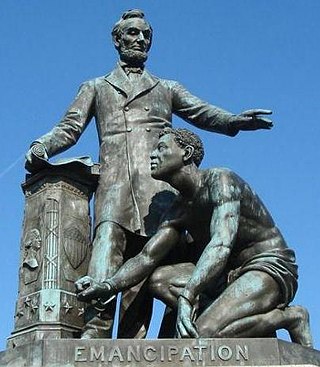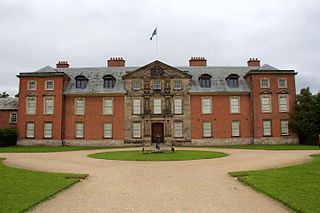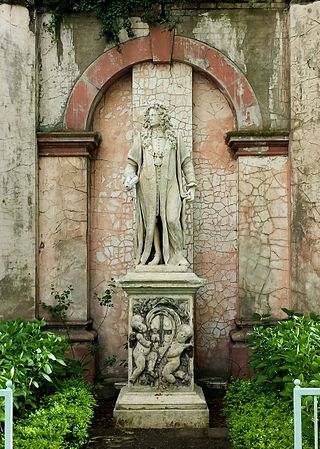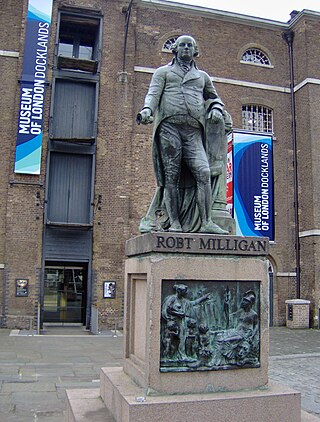
The National Trust is a charity and membership organisation for heritage conservation in England, Wales and Northern Ireland. In Scotland, there is the separate and independent National Trust for Scotland.

Dunham Massey is a civil parish in the Metropolitan Borough of Trafford, Greater Manchester, England. The parish includes the villages of Sinderland Green, Dunham Woodhouses and Dunham Town, along with Dunham Massey Hall and Park, formerly the home of the last Earl of Stamford and owned by the National Trust since 1976. Dunham Massey is in the historic county of Cheshire, but since 1974 has been part of Trafford Metropolitan Borough; the nearest town is Altrincham. At the 2001 census, the parish had a population of 475.

A lawn jockey is a statue depicting a man in jockey clothes, intended to be placed in front yards as hitching posts, similar to those of footmen bearing lanterns near entrances and gnomes in gardens. The lawn ornament, popular in certain parts of the United States and Canada in years past, was a cast replica, usually about half-scale or smaller, generally of a man dressed in jockey's clothing and holding up one hand as though taking the reins of a horse. The hand sometimes carries a metal ring and, in some cases, a lantern, which may or may not be operational.

Bowdon is a suburb of Altrincham and electoral ward in the Metropolitan Borough of Trafford, Greater Manchester, England.

Blackamoor is a type of figure/visual trope in European decorative art, typically found in works from the Early Modern period, depicting a man of sub-Saharan African descent, usually in clothing that suggests high status. Common examples of items and objects decorated in the blackamoor style include sculpture, jewellery, and furniture. Typically the sculpted figures carried something, such as candles or a tray. They were thus an exotic and lightweight variant for the "atlas" in architecture and decorative arts, especially popular in the Rococo period.

Stephen Foster is a landmark public sculpture in bronze by Giuseppe Moretti formerly located on Schenley Plaza in the Oakland section of Pittsburgh, Pennsylvania. Formerly sited along Forbes Avenue near the entrance of Carnegie Museum of Natural History, in the shadow of Dippy, a life-size sculpture of a Diplodocus dinosaur, and in close proximity to the University of Pittsburgh's Stephen Foster Memorial, the Foster statue is one of the city's best known and most controversial. It was removed on April 26, 2018 on the unanimous vote of the Pittsburgh Art Commission.

The Emancipation Memorial, also known as the Freedman's Memorial or the Emancipation Group is a monument in Lincoln Park in the Capitol Hill neighborhood of Washington, D.C. It was sometimes referred to as the "Lincoln Memorial" before the more prominent national memorial was dedicated in 1922.

Dunham Massey Hall, usually known simply as Dunham Massey, is an English country house in the parish of Dunham Massey in the district of Trafford, near Altrincham, Greater Manchester. During World War I it was temporarily used as the Stamford Military Hospital.

Christopher Columbus is a public artwork by Italian artist Enrico Vittori and located on the grounds of the Indiana Statehouse in Indianapolis, Indiana. The sculpture was installed on the southwest corner of the Indiana Statehouse lawn in 1920 as a gift from Italian immigrant communities in Indiana.

Equestrian Statue of Theodore Roosevelt is a 1939 bronze sculpture by James Earle Fraser. It was located on public park land at the American Museum of Natural History in New York City. The equestrian statue depicts Theodore Roosevelt on horseback. Walking on either side of him are two men, on one side a Native American and on the other, a sub-Saharan African.

The statue of Robert Clayton stands at the entrance to the North Wing of St Thomas' Hospital, Lambeth, London. The sculptor was Grinling Gibbons, and the statue was executed around 1700–1714. Sir Robert was a banker, politician and Lord Mayor of London. As President of St Thomas', he was responsible for the complete rebuilding of the hospital, and associated church in the late 17th century. The statue was designated a Grade I listed structure in 1979.

Christopher Columbus, or simply Columbus, is a 1955 sculpture by Edoardo Alfieri, originally installed outside Columbus, Ohio's City Hall, in the United States. The statue was unveiled in 1955, celebrating Christopher Columbus's voyages to the New World. It was removed in July 2020, in light of the explorer's abusive relationship with indigenous Americans.

The statue of Edward Colston is a bronze statue of Bristol-born merchant and trans-Atlantic slave trader Edward Colston (1636–1721). It was created in 1895 by the Irish sculptor John Cassidy and was formerly situated on a plinth of Portland stone in a public space known as "The Centre" in Bristol, until it was toppled by anti-racism protestors in 2020.

A statue of Robert Milligan was installed at the West India Docks in London, in 1813. Milligan was a merchant, and was largely responsible for the construction of the West India Docks. After being put in storage in 1943, it was re-erected by the London Docklands Development Corporation in 1997.

A statue of Philip Schuyler by J. Massey Rhind was installed outside Albany City Hall in Albany, New York, United States. The memorial was slated for removal in June 2020. It was removed from outside Albany City Hall on June 10, 2023.

A number of statues and memorials were the subject of protests and petitions during the George Floyd protests in the United Kingdom in 2020.

Altrincham Town Hall is a municipal building in Market Street, Altrincham, Greater Manchester, England. The town hall was the headquarters of Altrincham Borough Council.

The Emancipation Memorial, also known as the Freedman's Memorial or the Emancipation Group was a monument in Park Square in Boston. Designed and sculpted by Thomas Ball and erected in 1879, its sister statue is located in Lincoln Park in the Capitol Hill neighborhood of Washington, D.C. The Boston statue was taken down by the City of Boston on December 29, 2020, following a unanimous vote from the Boston Art Commission on June 30 to remove the memorial.





















